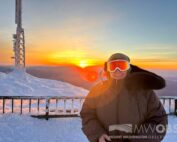Record Gust, Human Grit: 90 Years of Big Wind
By Ellen Estabrook | April 10, 2024
“’Will they believe it?’ Was our first thought. I felt then the full responsibility of that startling measurement…”
Salvatore Pagliuca, Weather Observer and electrical engineer, wrote those words in the observer logbook on April 12, 1934, upon noting a record wind velocity on the summit of Mount Washington of 231 miles per hour.
This record, confirmed by the National Weather Bureau, still stands as the fastest wind speed ever recorded at a staffed, non-automated station. It is here that we turn our attention to the great human effort behind this endeavor.
Peter Crane, curator of the Observatory’s collections, poignantly summarized this massive effort, saying, “The fact that the 1934 Observatory crew could accurately measure a wind of world record magnitude, during a period of very heavy icing, is a tribute to their planning and engineering acumen, as well as their commitment to establishing and maintaining this remote scientific outpost. Sometimes science advances by sparks of genius, but often it depends as much on dogged determination…”
In many ways, this phenomenon, and the successful recording of it, solidified two of the then two-year-old institution’s reasons for being: one, that Mount Washington’s summit was at the confluence of extreme weather discovery; and two, this necessitated both a research institution and continual human engagement with it.
In celebration of the 90th year of the Big Wind, we’re going to meet the team that was on the mountain that momentous day, and get a snapshot of what the experience was like from their perspective.
April 1934’s record wind was observed and recorded by Salvatore (Sal) Pagliuca, Alex McKenzie, and Wendell Stephenson. The fourth observer, Robert Stone, was transported down the mountain due to a skiing injury a few days before the record wind was observed. Also joining the crew were two guests, Arthur Griffin and George Leslie, two close friends of Pagliuca. Of course, the crew was also accompanied by several feline friends. Much of the accounts below are taken from Alexander A. McKenzie’s 1984 publication “World Record Wind: Measuring Gusts of 231 Miles an Hour,” in dedication to:
“the joint memory of Salvatore Pagliuca and Joseph Brooks Dodge whose sober industry and joyous humor created an institution from a winter’s adventure.”
Arthur (Art) Griffin was a renowned artist and photographer (who created the photographs and portraits below the night before the Big Wind). Known as one of New England’s earliest photojournalists, he shot for The Boston Globe, LIFE, Time, and other major publications, and was a pioneer in color film.
A Massachusetts native, Griffin traveled the northeast and beyond extensively, taking photographs that created a legacy that lives on today at the Griffin Museum of Photography. One can only imagine the artistic opportunities Mount Washington presented, as well as logistical challenges in taking photographs in the extreme weather. To pass the time and for entertainment, Art drew portraits of the crew and took photographs on the eve of the big wind, which perhaps serve as the sole visual documentation of that timeframe.

Photo by Arthur Griffin, © Griffin Museum of Photography.
During research, there was not much background information found on George Leslie, aside from being the second guest of Pagliuca, with a described “cheery presence” that undoubtedly helped throughout the extreme weather event:
“Despite the buffeting of the wind,” McKenzie recounts in World Record Wind, “Art and George made several trips outside to take photographs. Their cheery presence helped relieve the increasing tensions that seemed to build during any severe storm. He continues by noting their sense of humor, as well as their helpful demeanor when it came to chores and duties.

Arthur L. Griffin, left, and George Leslie in Alexander A. McKenzie’s publication, “World Record Wind: Measuring Gusts of 231 Miles an Hour.”
Alexander McKenzie, also known as “Mac,” was an observer and radioman from 1932 to 1937, and notably a member of the Observatory’s founding team. In “Mount Washington Reoccupied,” by Robert S. Monahan (also a founding member), McKenzie is described as “a Dartmouth ’32 graduate of considerable experience in radio and telephony.” He had instrumentally helped Joe Dodge develop a system of radio communication between AMC huts. As noted above, he authored “World Record Wind,” a 30-page publication with an aim to “assemble in one place a multifaceted story of the measurement of a world record wind across the summit of Mount Washington.” In it, McKenzie includes anemometer diagrams, barographs, and wind records alongside personal accounts to create a comprehensive report of that fateful day.

Drawing of Alexander A.McKenzie by Arthur Griffin dated April 11,1934 in “World Record Wind: Measuring Gusts of 231 Miles an Hour.”
Wendell Stephenson (Steve) was a “1930 graduate of the University of Chicago who could not stand being away from mountains,” according to William Lowell , author of “The Worst Weather on Earth: A History of the Mount Washington Observatory.” Stephenson was well-known in the outdoor community for walking across New Hampshire from Mount Monadnock and volunteering his time at the summit and Pinkham notch. He and his wife started Cardigan Lodge for the AMC later in 1934. “I was willing to do anything…and this was a helluva lot better than the squirrel stew where I’d been living at Carter Notch,” Stephenson said.
Employed at the Observatory at 26 years old in early May 1933 by Joe Dodge, Steve stayed on for over a year. “Mostly I was the cook, except that we all took our duty turns as observer, reading instruments regularly and noting anything unusual.” (Putnam, 1991). On the afternoon of April 12, Stephenson reported an average wind speed of 173 mph with gusts of 220+ mph.
As Weather Observer Alexandra Branton wrote in her April 2023 blog post, Remembering the Big Wind: “His fellow observers could not believe this, insisting that they time the gusts themselves. When Pagliuca began measuring with the stopwatch, the telegraph clicks suddenly increased in frequency. Timing the next three clicks only took 1.17 seconds. Although the calculation to translate this into a wind speed had not been done yet, Pagliuca recalls knowing immediately that it was a record.”

Wendell F. Stephenson, left, and Alexander A. McKenzie, photographed by Arthur Griffin.
Sal Pagliuca, Chief Observer at the time and for another year following, wrote the logbook entries during the Big Wind. Pagliuca was one of the four original weather observers who founded the Observatory, and according to William L. Putnam in “The Worst Weather on Earth,” he was “well on the way of becoming a professional meteorologist but had been working most recently as hutmaster at the AMC’s newly opened Galehead Hut.” Originally from Aversa, Italy, Pagliuca had extensive training and experience in electrical engineering and a strong interest in science and mountain weather. He had spent 10 months “snapping stop watches” in a laboratory which provided sound practice for the techniques needed that day.
“We had measured by means of an anemometer the highest natural wind velocity ever recorded officially anywhere in the world,” he wrote in his logbook.

Drawing of Salvatore Pagliuca by Arthur Griffin.
Through a snapshot of the individuals present during the record wind event, we can begin to understand and better appreciate both the grit and ingenuity present on the mountain that day, as well as celebrate the crews, then and now, who continue to uphold the tradition of human triumph in the name of weather discovery.
This April, we celebrate the dedicated and diligent individuals at the Observatory during this world record event, as well as the crew, past and present, who continue to uphold the tradition of human triumph in the name of weather discovery.
Join us in celebrating the 90th anniversary of Big Wind Day in just a few weeks. We’ll be offering an array of engaging events to learn, celebrate, and explore this landmark event. Alongside a public celebration in North Conway the weekend of the 12th, we’ll also be featuring digital and print accounts from our archives as well as virtual education programs. Learn more at mountwashington.org/events.
From Mount Washington to Antarctica
From Mount Washington to Antarctica By Charlotte Markey What do Antarctica and the summit of Mount Washington have in common besides weather? Having worked as support staff for both locations, I can tell you
Mount Washington Observatory to Host 90th Anniversary Big Wind Day Celebration
Mount Washington Observatory to Host 90th Anniversary Big Wind Day Celebration North Conway, NH – March 23, 2024 – In commemoration of the 90th anniversary of the highest wind speed ever recorded at a
Spring is Here
Spring is Here By Alexis George Our snowpack, although still present, has slowly been dwindling over the course of this month. At the beginning of March, there was a snow depth of 27 inches



